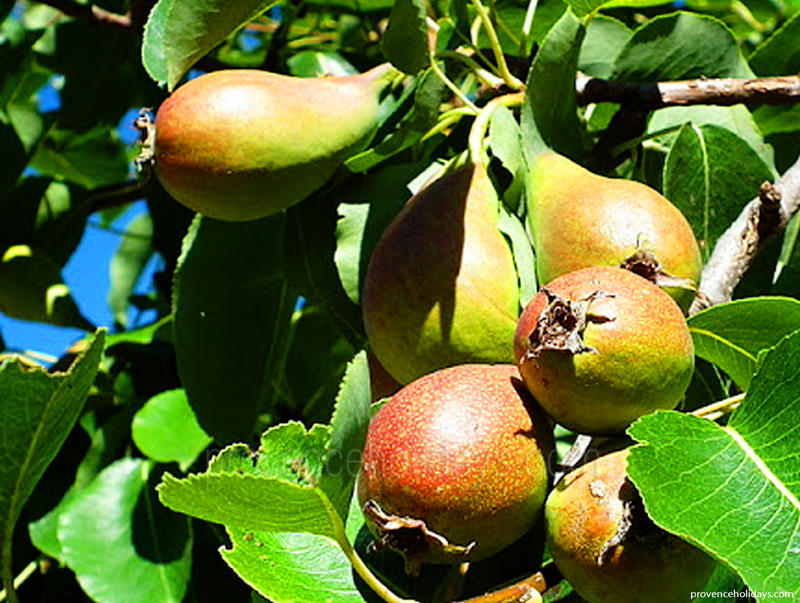Pears
History
Originating in Central Asia, the cultivation of the pear began in China more than 4 millennia ago. It then spread throughout Europe where the Greeks and Romans adopted it. The pear was already eaten raw, cooked, dried and as a fermented drink. It made its appearance in France in the 16th century where, according to legend, François I stopped at Gap on his way back from Italy and tasted the cremesin pear. It was Louis XIV who popularised it thanks to his gardener, Jean-Baptiste de La Quintinie, who cultivated several species in the king's famous kitchen garden. The robin was then named the "royal", in honour of Louis XIV who was crazy about it! This fruit was received as a gift, accompanied by a glass of champagne, at the coronation of the sovereigns in Reims. During the ceremony, the mayor said the now famous phrase: "We offer you the best we have: our wines, our pears and our hearts". From the end of the 18th century, Provençal orchards produced a large quantity of pears.
Over the centuries, many varieties have been selected and retained. In France, about ten are currently produced, but there are several thousand. One of the most popular is the Conference, born in England, which owes its name to the prize it won at the British National Pear Conference in 1885.
Several summer varieties are grown in Provence, mainly in the Loire Valley, the South-West and the Ile-de-France.
Varieties and Flavours
A distinction is made between summer pears, harvested from July onwards, and winter pears, harvested from September onwards. The main summer varieties are:
- Beurré Giffard: pale yellow with a red tint and fine, melting and juicy flesh. It is very sweet.
- Dr. Jules Guyot: yellow in colour with fine, melting and sweet flesh.
- Williams: yellow with a red tint,with fine, sweet and juicy flesh and a musky aroma.
- Beurré Hardy: bronze green in colour with fine, juicy, sweet and fragrant flesh.
The main winter varieties include:
- Conference: straw-yellow with a green tinge. Its flesh is fine and melting and has a slightly acidic taste.
- Louise Bonne d'Avranches: green-yellow with a red tint and sweet, fragrant and tangy flesh.
- General Leclerc: yellow in colour with fine, tender, juicy flesh and a slightly acidic taste.
- Doyenné du Comice: yellow with red tints and sometimes dented with fine, melting, juicy, sweet and acidulous flesh.
The Question on Everyone's Mind
Can pears be stored for a long time?
In general, yes, but it depends! The pear is a climacteric fruit: if you pick it before it is ripe, it will finish ripening.
Pears, like apples, can be stored but the winter pears keep better than the summer ones: those harvested in October are fully ripe in December and can be eaten until March or even May. They are then in a period of maturation which will allow them to express all their flavours.
To keep the pears as long as possible, place them in a cool room (5°C), in a single layer on shelves with a grid, avoiding them touching. Check them regularly and remove those that are starting to spoil.
How to Eat Them
Raw or cooked, the pear accompanies savoury dishes with a certain subtlety. It can be found in mixed salads, combining carrots, nuts and cheese. Fried in butter or poached, it adds flavour to meat dishes, duck, poultry, lamb or game. It also goes well with scallops and foie gras. In its sweet version, it is used in all desserts: fruit salads, bavarois, charlottes, pies, etc. It can also be prepared in compote, jam or jelly. Poached in wine, red or white, or in syrup, it is a delight! And it goes well with chocolate and almonds! Pear brandy is a must-try!
A Recipe
Pears poached in Honey and Spices:
|
Preparation time: 15 mins Cooking time: 45 mins Difficulty: easy Cost: € |
Ingredients for 4 persons : 4 ripe but firm pears |
- Put the water in a frying pan or saucepan, add the sugar, honey and orange peel. Split the vanilla pod in half, scrape out the seeds and add them to the pan with the pod. Bring to the boil.
- Peel the pears, leaving the stems on, and add lemon juice to them.
- As soon as the spiced syrup boils, dip the pears in it and cook them for about 40 minutes on a simmer, turning them gently from time to time.
- The pears are done when they are completely soft.
- Remove the pan from the heat and let the pears cool to room temperature.
- Arrange the pears on plates, drizzle with syrup and decorate with the spices. Serve with a scoop of vanilla ice cream.
- Enjoy!
Where to Buy Them
The pear can be found on every market stall in Provence.
To buy them directly, this site lists a large number of producers: https://granvillage.com/l/13-provence-alpes-cote-d- azur/?product=73
Sens&Saveurs, ![]() 43 boulevard des Tilleuls, Manosque
43 boulevard des Tilleuls, Manosque
If you are not far from Manosque, take the time to visit Sylvain Nowak's restaurant. The famous chef loves to cook the sarteau pear, in both savoury and sweet versions.
Pear Events
Every year, at the beginning of November, the Foire de la Poire Sarteau takes place in La Javie (Alpes-de-Haute-Provence). A festive moment not to be missed.

